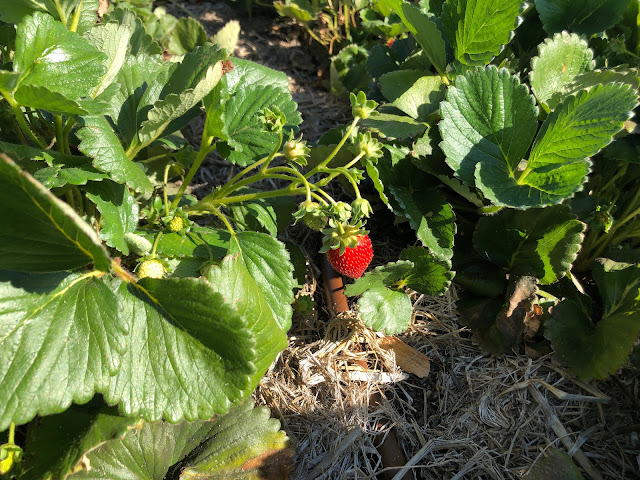
Expect just as much interest in plants during 2021, with some refinements

|
|
Strawberries as trendy? That's one prediction for this growing year. (Photo: Kathy
Morrison)
|
Hey, we're trendy! But that's no surprise, is it? We've all been in the thick of it, trying to find the seeds we want or the fruit trees we envision, jumping onto new online sites for our favorite plant sales -- with curbside pickup! -- and sharing soil and amendment sources.
Most of us are still at home more than we were in 2019, thanks to the coronavirus, and we want to build on what we tried last year.
Mostly out of curiosity, I took a spin through several online sites that featured "garden trends for 2021." Not too many surprises for anyone who's been paying attention, but in general, they include:
Houseplants will be more popular. (Yes, they're great backgrounds for Zoom meetings.) Succulents remain hot, with tropicals right behind. Urban gardening continues to grow, as folks with only balconies or patios find ways to add plants. This goes along with more container gardening in general, and raised beds, too. And of course, vegetables and other edibles are big, big, big.
More interesting notes:
Better Homes and Gardens cites real numbers for last year's gardening explosion. Gardeners in the United States went from 42 million people to 63 million in 2020 -- a 50 percent increase. Suppliers just weren't ready for that boom, which is why seeds and transplants and fertilizers were so hard to find last spring. But companies will be better prepared this year. BHG quotes Bonnie Plants CEO Mike Sutterer as expecting at least 80 percent of those 21 million newbies to continue this year.
Another intriguing stat from that story: A majority of the new gardeners were men 35 and younger. Since home gardening tends to be dominated by women, especially among younger people -- it evens out among retirees, I've noticed -- that could mean the trend away from growing merely ornamental annual flowers will speed up.
For BobVila.com , writer Mark Wolfe talked trends with Katie Dubow, president of Garden Media Group. Among her observations: Gardening space is a hot selling point for homebuyers. (Sacramento says, "No kidding!") Creating a habitat, rather than merely a collection of plants, is getting more attention. And experienced gardeners, with more time available, are taking on more ambitious projects.
Of course California gardeners, because we can grow for so much of the year, and grow so many things, have been ahead of many trends going national. These include planting for pollinators, sustainable gardening, removing lawns in favor of edibles or low-water plants, and using environmentally safe products in our gardens. SummerWinds Nursery , which has outlets in the South Bay, notes these trends, and also predicts that newbie gardeners who jumped into vegetables last year will add fruiting plants this year: Strawberries and patio-size fruit trees are likely to get snapped up quickly.
If you've wanted to try growing strawberries, check out this guide on choosing a variety in the California GardenWeb (I'd add the Albion variety to that list) and this planting and pest-management guide from UC Integrated Pest Management. Peaceful Valley Farm & Garden Supply (groworganic.com) also offers a video on growing strawberries .
Comments
0 comments have been posted.Sacramento Digs Gardening to your inbox.
Sites We Like
Garden Checklist for week of July 21
Your garden needs you!
* Keep your vegetable garden watered, mulched and weeded. Water before 8 a.m. to reduce the chance of fungal infection and to conserve moisture.
* Feed vegetable plants bone meal, rock phosphate or other fertilizers high in phosphate to stimulate more blooms and fruiting. (But wait until daily high temperatures drop out of the 100s.)
* Don’t let tomatoes wilt or dry out completely. Give tomatoes a deep watering two to three times a week.
* Harvest vegetables promptly to encourage plants to produce more. Squash especially tends to grow rapidly in hot weather. Keep an eye on zucchini.
* Pinch back chrysanthemums for bushy plants and more flowers in September.
* Remove spent flowers from roses, daylilies and other bloomers as they finish flowering.
* Pinch off blooms from basil so the plant will grow more leaves.
* Cut back lavender after flowering to promote a second bloom.
* It's not too late to add a splash of color. Plant petunias, snapdragons, zinnias and marigolds.
* From seed, plant corn, pumpkins, radishes, winter squash and sunflowers.